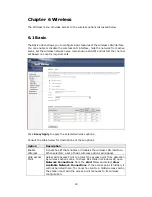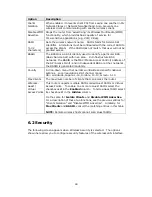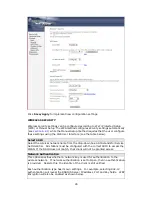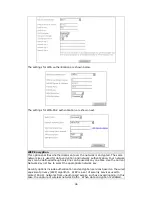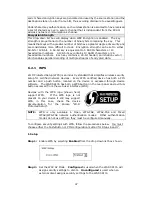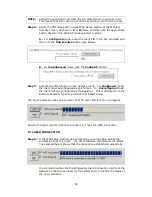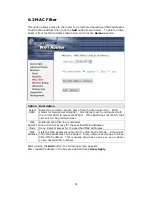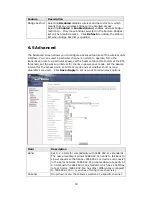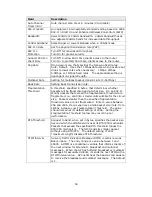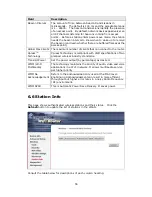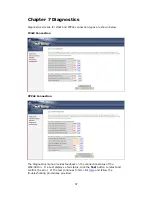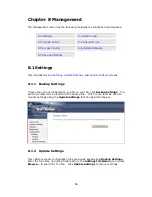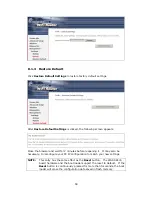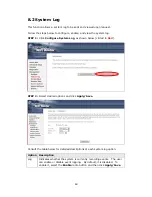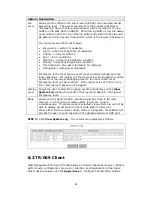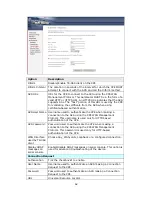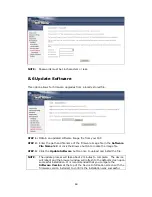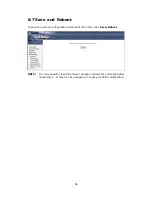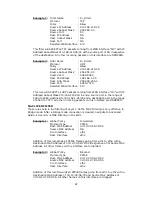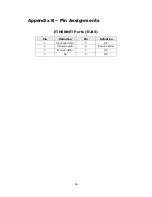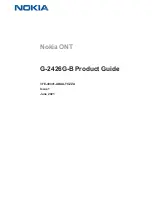
54
Field
Description
Auto Channel
Timer (min)
Auto channel scan timer in minutes (0 to disable)
802.11n/EWC
An equipment interoperability standard setting based on IEEE
802.11n Draft 2.0 and Enhanced Wireless Consortium (EWC)
Bandwidth
Select 20GHz or 40GHz bandwidth. 40GHz bandwidth uses
two adjacent 20GHz bands for increased data throughput.
Control Sideband
Select Upper or Lower sideband when in 40GHz mode.
802.11n Rate
Set the physical transmission rate (PHY).
802.11n
Protection
Turn Off for maximized throughput.
Turn On for greater security.
Support 802.11n
Client Only
Turn Off to allow 802.11b/g clients access to the router.
Turn On to prohibit 802.11b/g clients access to the router.
54g Rate
Drop-down menu that specifies the following fixed rates:
Auto: Default. Uses the 11 Mbps data rate when possible but
drops to lower rates when necessary. 1 Mbps, 2Mbps,
5.5Mbps, or 11Mbps fixed rates. The appropriate setting is
dependent on signal strength.
Multicast Rate
Setting for multicast packet transmit rate (1-54 Mbps)
Basic Rate
Setting basic transmission rate.
Fragmentation
Threshold
A threshold, specified in bytes, that determines whether
packets will be fragmented and at what size. On an 802.11
WLAN, packets that exceed the fragmentation threshold are
fragmented, i.e., split into, smaller units suitable for the circuit
size. Packets smaller than the specified fragmentation
threshold value are not fragmented. Enter a value between
256 and 2346. If you experience a high packet error rate, try to
slightly increase your Fragmentation Threshold. The value
should remain at its default setting of 2346. Setting the
Fragmentation Threshold too low may result in poor
performance.
RTS Threshold
Request to Send, when set in bytes, specifies the packet size
beyond which the WLAN Card invokes its RTS/CTS mechanism.
Packets that exceed the specified RTS threshold trigger the
RTS/CTS mechanism. The NIC transmits smaller packet
without using RTS/CTS. The default setting of 2347
(maximum length) disables RTS Threshold.
DTIM Interval
Delivery Traffic Indication Message (DTIM) is also known as
Beacon Rate. The entry range is a value between 1 and
65535. A DTIM is a countdown variable that informs clients of
the next window for listening to broadcast and multicast
messages. When the AP has buffered broadcast or multicast
messages for associated clients, it sends the next DTIM with a
DTIM Interval value. AP Clients hear the beacons and awaken
to receive the broadcast and multicast messages. The default
is 1.




